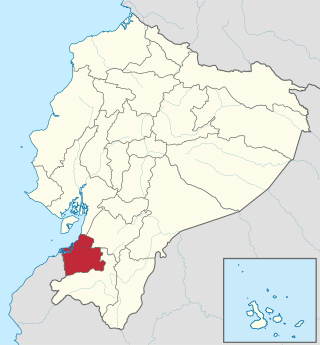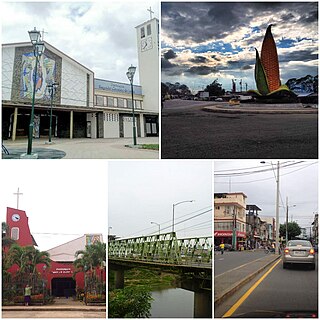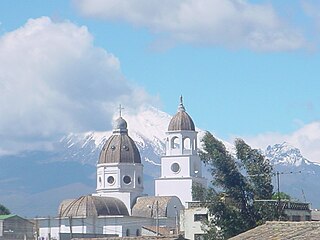
Guayas is a coastal province in Ecuador. It is bordered to the west by Manabí, Santa Elena, and the Pacific Ocean ; to the east by Los Ríos, Bolívar, Chimborazo, Cañar, and Azuay; to the north by Los Ríos and Bolívar; and to the south by El Oro and the Pacific Ocean.

El Oro is the southernmost of Ecuador's coastal provinces. It was named for its historically important gold production. Today it is one of the world's major exporters of bananas. The capital is Machala.

Los Ríos is a province in Ecuador. The capital is Babahoyo. The province was founded on October 6, 1860. Under legislative decree. Babahoyo was made its capital on September 30, 1948.

Esmeraldas is a coastal city in northwestern Ecuador. It is the seat of the Esmeraldas Canton and capital of the Esmeraldas Province. It has an international sea port and a small airport. Esmeraldas is the major seaport of northwestern Ecuador, and it lies on the Pacific coast at the mouth of the Esmeraldas River. It is the antipodes of Padang, Indonesia. The city is the principal trading hub for the region's agricultural and lumber resources, and is the terminus of the 313-mile (504-km) Trans-Ecuadorian Pipeline from the oil fields in northeastern Ecuador.

Babahoyo, founded May 27, 1948, by legislative decree, is the capital of the Los Ríos province of Ecuador. Its population is cited around 98,000. It is bordered by two rivers, the San Pablo and the Caracol, which join to form the Babahoyo River. This meets the Daule River to form the Guayas River, which runs to the Pacific Ocean at the Gulf of Guayaquil.

Quevedo is a city in Ecuador located in the Los Ríos Province. It is the seat of Quevedo Canton, a vibrant community founded in 1943. According to the latest census, Quevedo's population is 177,792. Located at 237 km SW of Quito, or, 183 km NE of Guayaquil. Quevedo is one of the fastest-growing cities in Ecuador and it is mainly known for its agricultural tradition. Quevedo's agroindustrial complex is one of the leading exporters in the world of banana, cacao, passion fruit and coffee bean. In recent years non-agricultural activities have experienced significant progress mainly in the financial and educational sectors.
Piñas is a canton in the El Oro Province, Ecuador. Its seat is Piñas. It is also known as the "Orchid of The Andes" because of the many orchids grown nearby. The town was named Piñas by Juan de Loayza, in honor of his homeland Piñas in Spain. It is located 1,126 metres (3,694 ft) above sea level.

Santo Domingo de los Tsáchilas is a province in the Republic of Ecuador, created in October 2007 from territory previously in the province of Pichincha.

La Maná is a town in the Cotopaxi Province of Ecuador. It is the seat of the La Maná Canton. La Maná, is one of seven canton of the Cotopaxi Province in Ecuador. La Maná is not only a canton, but also is the name the main town. The canton has a total area of 66,258 acres. It is the sixth largest canton of the province of Cotopaxi.

Ventanas it is an Ecuadorian city; head of the Ventanas Canton, in the Los Ríos Province, as well as the fourth most populated city in the Province of Los Ríos. It is located in the center of the coastal region of Ecuador, on an extensive plain, crossed by the Zapotal River, at an altitude of 24 meters above sea level and with a rainy tropical climate of 26 °C on average. It is called "The Corn Capital of Ecuador" for its important production of corn. At the 2022 census it had a population of 41,531, making it the thirty-eighth most populous city in the country. It is part of the metropolitan area of Babahoyo, since its economic, social and commercial activity is strongly linked to Babahoyo, being a "dormitory city" for thousands of workers who travel to that city by land daily. The conglomerate is home to more than 250,000 inhabitants.

Latacunga Canton is one of seven cantons of the Cotopaxi Province in Ecuador. Its population at the 2001 census was 143,979. Its capital is the town of Latacunga.

Palestina Canton is a Canton located in northern Guayas, Ecuador, created in 1988. Palestina Canton has a population of 18,019, and its nearby cities are Santa Lucía, Daule, Colimes and Balzar. The town of Palestina is located 80 km north of Guayaquil, at the Northern Centre of the province. The canton occupies a territory of 186.6 km2.

Pedro Carbo Canton is a land-locked coastal canton located in Guayas Province in Ecuador, near Manabí Province. Its capital is the town of Pedro Carbo. It is located at the 63 kilometer marker on the road from Guayaquil to Manabí. It is the seat of Pedro Carbo Cantón, founded in 1984. As of the census of 2001, there are 36,711 people residing within canton limits. A new census was conducted in 2010 but results are yet unknown. The city is named after Pedro Carbo Noboa, a 19th-century politician, diplomat and writer from Guayaquil.

Buena Fe Canton is a canton in Los Ríos Province, Ecuador. Its capital is the town of Buena Fe. Its population at the 2001 census was 47,361.

Puebloviejo Canton is a canton of Ecuador, located in the Los Ríos Province. Its capital is the town of Puebloviejo. Its population at the 2001 census was 29,420.

Quevedo Canton is a canton of Ecuador, located in the Los Ríos Province. Its capital is the town of Quevedo. Its population at the 2001 census was 139,790.

Valencia Canton is a canton of Ecuador, located in the Los Ríos Province. Its capital is the town of Valencia. Its population at the 2001 census was 32,870.

Ventanas Canton is a canton of Ecuador, located in the Los Ríos Province. Its capital is the town of Ventanas. Its population at the 2001 census was 71,145.

El Airo is a village located in the southern part of Ecuador's Loja province known for growing some of the best coffee in Ecuador. It is in the northwestern part of the Espindola canton about 25 km from Amaluza, the canton's capital.

Ecuadorian Sumatra Tobacco is a tobacco grown in Quevedo, a fertile sub-tropical region in Los Ríos Province, Ecuador, and is used primarily as a wrapper for premium cigars.



















